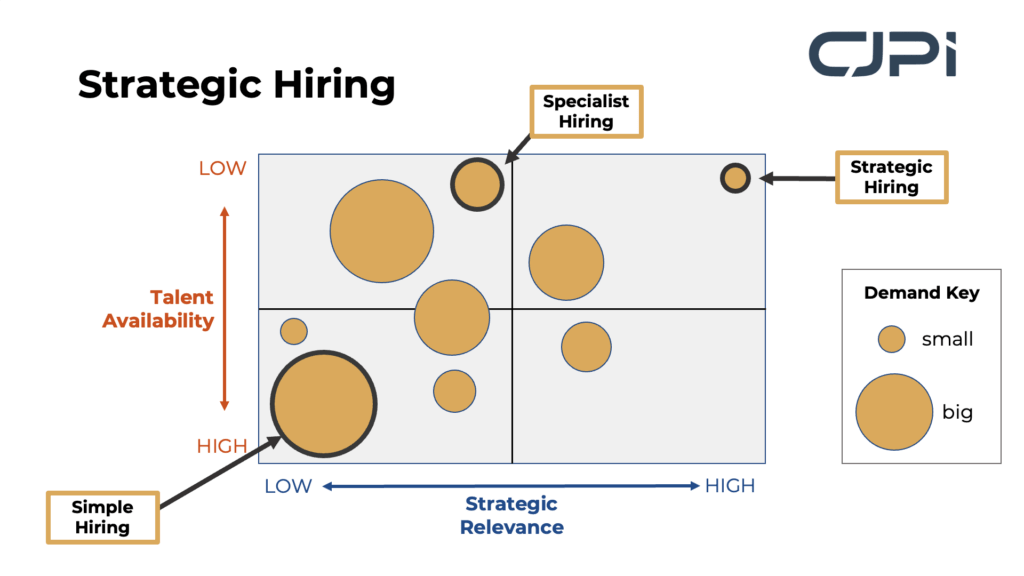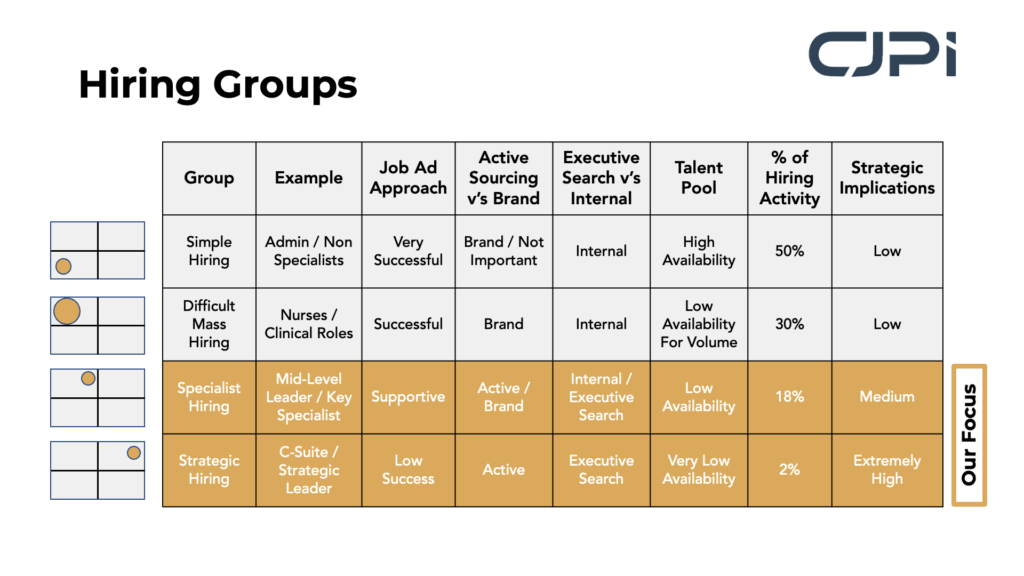When filling strategically significant positions within an organisation, the stakes are high. The cost to rehire when it doesn’t work out with executive-level roles is estimated to cost businesses £200,00 ($240,000), so how does that compare with executive search costs?
Companies must find the right person for any job, but a single misstep when recruiting CEOs or other senior and strategic leaders can have severe consequences for an organisation. This is where executive search firms come in, leveraging their expertise and resources to help find the perfect candidate which is a strong technical and culture match. However, their services come at a cost, and organisations need to understand these expenses compared with the risk of trying to recruit senior leaders in-house.
Even with the most capable and sizeable internal talent team, in-house recruitment of executive roles requires a different approach – that’s why most of the biggest companies use executive search partners for senior roles.
The Structure of Executive Search Costs
Executive search firm fees in the UK, America and Europe are typically structured as retained fees.
In a retained fee arrangement, the client pays the executive search firm a fee to secure their services. This fee is usually calculated as a percentage of the candidate’s estimated first-year compensation, ranging from around 25% to 35%. Sometimes this is quoted as a percentage of the total remuneration offered to the chosen candidate, but in some cases, firms (including CJPI) will offer a fixed fee so that you can budget accurately and avoid ‘fee-creep’.
Typically the fee is split into and paid in thirds, with the consultancy only receiving payment for the next third based on tangible milestones and deliverables. For example;
- The first ‘third’ of the fee payable on instruction
- The second ‘third’ of the fee payable on delivery of the shortlisted candidates
- The final ‘third’ of the fee is paid on the offer of the role to a candidate selected by the client.
This structure gives clients assurance of their costs based on the role whilst sharing the recruitment risk and reward with their executive search partner, who is required to deliver tangible results at every step of the way whilst being retained to ensure their focus and attention on the role.
So Why Not Do It Yourself?
One of the questions we are often asked by clients at CJPI – particularly those with internal talent acquisition teams – is “Why can’t we try this ourselves” or “Why can’t our internal recruiters just do this”. In other cases, businesses have already spent considerable time and cost in recruiting the wrong fit before engaging with an executive search firm to access the expertise and tools which are inaccessible to them directly.
Critically, we know that the best candidates are far less likely to engage with internal hiring managers or recruitment teams directly, which significantly reduces your talent pool – even if you know exactly where to look.
A report by the Economist Intelligence Unit, titled “Talent and the New World of Hiring” discusses how the traditional hiring process is being disrupted by changing workforce demographics and technological advancements. The report suggests that as the competition for senior talent intensifies, the role of executive search firms will become increasingly important in helping organisations find, attract, and retain the very best candidates.
We’re not suggesting recruitment of executives in-house never works, but the chances of finding the best talent available are significantly reduced, and the access to the specialist tools required to reveal the most accurate assessment insights is often limited with in-house teams who are experienced in recruiting for specialist mass roles, or general business functions.
Here is why…

When we look at strategic hiring in particular, as the above model shows, these roles are a tricky combination of;
- Small demand (there are not many of these roles which come available when compared with the landscape of all recruitment)
- They hold a very high strategic relevance (their risk and benefits are amplified considerably when compared with all recruitment activities)
- Talent availability is very low (there are very few capable of filling such a role and most of those people are actively employed. This makes ensuring the entirety of the potential market being fully addressed, critical.)

When looking at each of those hiring groups (above) you can see the requirements for recruiting each hiring group in an optimal way, such as the effectiveness of the “job ad” approach and whether active sourcing or brand is most critical.
The bottom row of this table explains the approach with a senior leadership role which has a low success of job adverts alone, and requires active sourcing (headhunting) to identify a very low talent pool availability with extremely high strategic implications – this is the sweet spot for professional executive search firms such as CJPI.
So What Are The Risks of In-House Executive Recruitment?
Here are just some of the common risks of attempting an executive search in-house;
- Time-consuming process – Filling an executive role in-house can be a lengthy and time-consuming process, especially for niche or highly specialised leadership roles (and that is assuming you have a team who know how to approach it and where to look!). This may result in key positions remaining vacant for extended periods, which can harm the organisation’s performance and productivity. This distracts your internal talent team from their day jobs and fulfilling the rest of your workforce requirements.
- Limited candidate pool – In-house recruitment teams are not likely to have access to the extensive networks that executive search firms can access, which could limit the potential candidate pool. This could result in a less diverse and less qualified set of candidates for the position and selecting the best of the rest, rather than the best of the best.
- Inadequate assessment – In-house recruitment teams often lack the expertise and tools required to effectively assess executive-level candidates – where competency-based assessment seldom yields sufficient results. This could lead to hiring a candidate who is not the right fit for the role or the organisation. The tools used to assess executive candidates are often proprietary and professionally administered by experts and not available to employers directly.
- Confidentiality risks & barriers – Executive searches require a high degree of discretion and confidentiality the reality is that it takes considerable assurance for a senior leader to engage in a potential new opportunity and the better the candidate is, the more credibility they seek. In-house recruitment teams are not able to guarantee the same level of privacy and as a result, we know it is far less likely that a senior leader within a competing organisation would engage with an internal recruitment function. This significantly reduces the potential candidate pool.
- Loss of objectivity – In-house recruitment teams may be influenced by internal politics or biases, which could affect their ability to make impartial decisions about candidates.
- Getting It Wrong – By far the largest risk is not getting an optimal candidate through a lack of experience in aligning strategy with the right leadership to deliver it. This is compounded when there is pressure on an internal recruitment function to appoint, and they do so without having explored the entire market map (ie: from applications from job boards alone).
Costs of In-House Executive Recruitment
In place of a clear retained fee structure proposed by an executive search firm, paid at various deliverables/milestones, the cost of attempting this in-house can work out more costly, even if you do get it right.
- Internal resource – Executive recruitment is a highly specialised and consultative process. That is why most internal recruitment teams have never hired an executive-level role themselves. It requires a significant investment of time, effort, and expensive resources. Trying to use internal resources will likely distract the internal team from the day-to-day workforce requirements – impacting overall efficiency and productivity.
- Advertising and job board fees – Companies conducting in-house recruitment will need to advertise the position on various job boards (which has very little success for senior roles) and access to strategic paid ad strategies across social media platforms, and industry-specific forums is limited and expensive.
- Technology and tools – In-house recruitment teams may need to invest in additional software, tools, and assessment methods to manage the executive recruitment process effectively. These investments can be costly, particularly if they are not used regularly. Indeed, some of these tools, such as our expert Occupational Personality Profiling may not even be accessible to non-specialists.
- Opportunity cost – The time and resources spent on in-house executive recruitment could be allocated to other strategic initiatives or revenue-generating activities, resulting in potential missed opportunities. This is further compounded when moving experienced resources from their day jobs into executive search, where the overwhelming majority of these teams have little to no experience. Therefore the process takes longer, has less chance of success and less chance of identifying the optimal pool of candidates to select from.
- Costs of Getting it Wrong – This is the big one! Research shows the likelihood of getting a sub-optimal hire is greatly increased when trying to recruit these strategic roles in-house. The cost of getting it wrong can be extreme – the average cost of replacing a mid-level employee is over £30,000 ($40,000) and with executives that figure is closer to £200k ($240k). However, at the very least, it is quantifiable from the actual cost of recruiting the sub-optimal hire (internal team time, interview costs etc), the salary paid to the sub-optimal hire and any negative implications they may leave behind.
Conclusion
Executive search costs are often calculated based on a percentage of remuneration for the role and paid at stages aligned by deliverables which reduces risk. Organisations must understand these costs and carefully consider their options, risks and rewards. By doing so, they can weigh up the budget and share the risk – without exposing themselves to unnecessary pitfalls.
If you have a strategic role for which you are considering working with an executive search firm, you can find out more about our executive search services here, or contact us for informal advice in the first instance.



